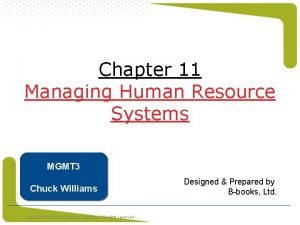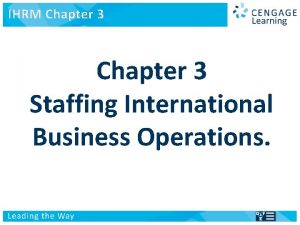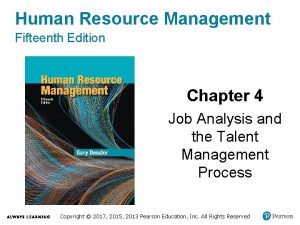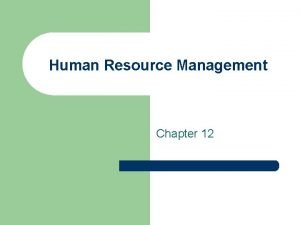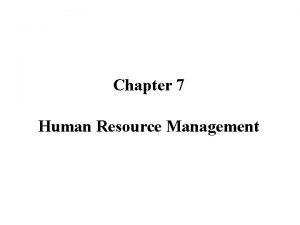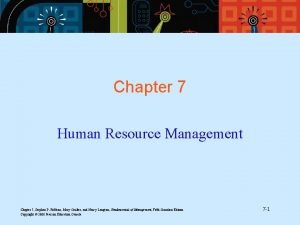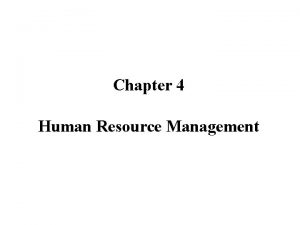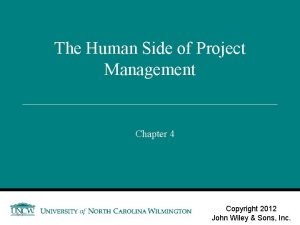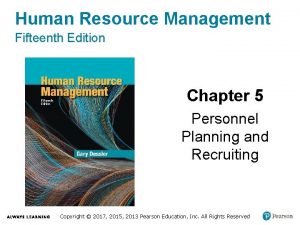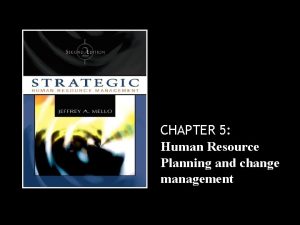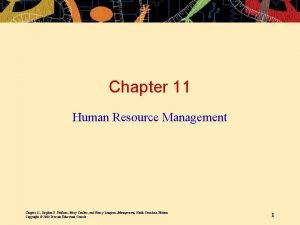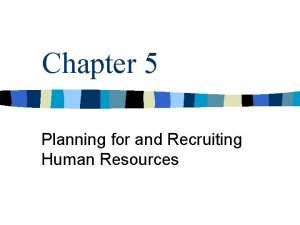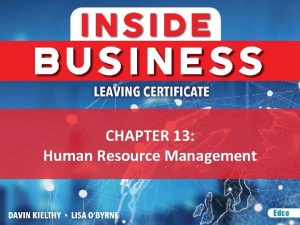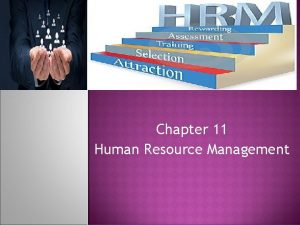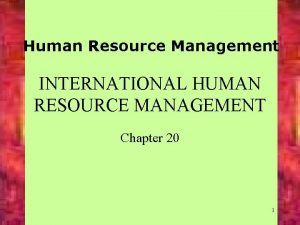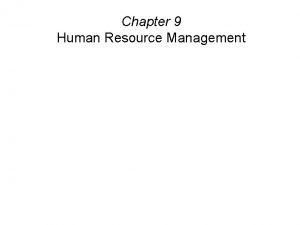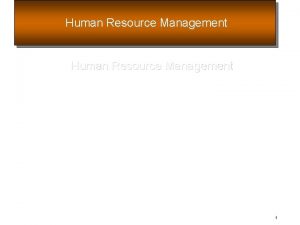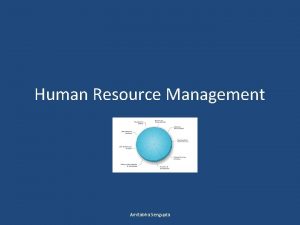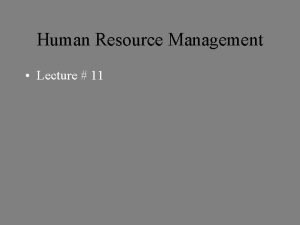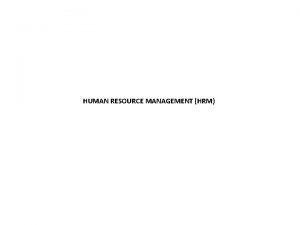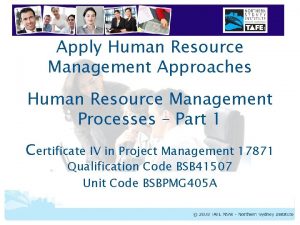Chapter 7 Human Resource Management Human Resource Management





















- Slides: 21

Chapter 7 Human Resource Management

Human Resource Management Ø Human Resource Management includes all activities used to attract and retain employees and to ensure they perform at a high level in meeting organizational goals. Ø These activities are made up of: 1. Recruitment and selection. 2. Training and development. 3. Performance evaluation and feedback. 4. Pay and benefits. 5. Labor relations.

Components of a HRM System Recruitment & Selection work Relations Pay & Rewards Training & Development Performance evaluation & Feedback

HRM Functions Ø HRM Functions should be consistent with the others, organization structure, and strategy. Main functions are: 1. Recruitment and Selection : Used to attract and hire new employees who have the abilities, skills, and experiences that will help an organization achieve its goals. 2. Training & Development: – Ensures that organizational members develop the skills and abilities that will enable them to perform their jobs effectively in the present and the future – Changes in technology and the environment require that organizational members learn new techniques and ways of working

HRM Functions 3. Performance Appraisal and feedback: – Provides managers with the information they need to make good human resources decisions about how to train, motivate, and reward organizational members – Feedback from performance appraisal serves a developmental purpose for members of an organization 4. Pay and Benefits: Ø high performing employees should be rewarded with salaries raises, bonuses. – Increased pay provides additional motivation. – Benefits, such as health insurance, reward membership in firm.

HRM Functions HRM Components 5. Labor relations: Ø Managers need an effective relationship with work unions that represent workers. – Unions help establish pay, and working conditions. Ø If management moves to a decentralized structure, HRM should be adjusted as well.

1. 1 Recruitment 1. External recruiting: managers look outside the firm for people who have not worked at the firm before. Ø Managers advertise in newspapers, hold open houses, recruit at universities, and on the Internet. – External recruitment is difficult since many new jobs have specific skill needs. 2. Internal Recruiting: positions filled within the firm. Ø Internal recruiting has several benefits: – Workers know the firm’s culture, may not have new ideas. – Managers likely already know the candidates. – Internal advancement can motivate employees.

1. 2. Selection Process Ø After a pool of applicants are identified, qualifications related to the job requirements are determined: 1. Background Information: includes education, prior employment, college major, etc. 2. Interview: almost all firms use one of two types: – Structured interview: managers ask each person the same job-related questions. – Unstructured interview: held like a normal conversation. 3. Physical Ability Test: measure strength & endurance. – Good for physically demanding jobs.

1. 2. Selection Process 4. Paper & Pencil Tests: Either an ability and personality test. – Ability test: assess if applicant has right skills for the job. – Personality test: seek traits relevant to job performance. – Be sure test is a good predictor of job performance. 5. Performance Tests: measure job performance. – Typing speed test is one example. – Assessment Center: candidates assessed on job-related activities over a period of a few days. 6. References: outside people provide honest information about candidate. – Can be hard to get accurate information.

Selection Tools Background Information Interviews References Selection Performance tests Paper tests Physical Ability tests

2. Training & Development Ø Ø Training: Teach organizational members how to perform current jobs. – Help worker’s acquire skills to perform effectively. Development: build worker’s skills to enable them to take on new duties. – Training used more often at lower levels of firm, development is common with managers. – An Assessment should be taken first to determine who needs which program and what topics should be stressed.

Types of Training Needs Assessment Training Classroom Instruction On-the-job Training Apprenticeships Development Classroom Instruction On-the-job Training Varied work experiences Formal Education

Types of Training 1. Classroom Instruction: workers acquire skills in classroom. Ø Includes use of videos, role-playing, . 2. On-the-Job Training: learning occurs in the work setting as worker does the job. – Training given by co-workers and can be done continuously. 3. Apprenticeships: worker engages with a leading worker to learn a skill.

3. Performance Appraisal and Feedback • Performance Appraisal: – The evaluation of employees’ job performance and contributions to their organization. • Performance Feedback: – The process through which managers share performance appraisal information, give subordinates an opportunity to reflect on their own performance, and develop with subordinates, plans for the future.

3. 1 Types of Performance Appraisal 1. Trait Appraisals: – Assessing subordinates on personal characteristics that are relevant to job performance. – Disadvantages of trait appraisals: • Employees with a particular trait may choose not to use that particular trait on the job. • Traits and performance are not always obviously linked • It is difficult to give feedback on traits.

3. 1. Types of Performance Appraisal 2. Behavior Appraisals: Assesses how a worker does the job. – Focuses on what a worker does and provides good feedback options. 3. Results appraisals: Assessments based on what a worker achieves. – Sales reps are usually evaluated on what they sell. 4. Objective appraisals: – Assesses performance based on facts (e. g. , sales figures).

Who Appraises Performance? Supervisors Peers Sources of performance appraisals Self Customers & Clients Subordinates

3. 2 Effective Feedback Guidelines 1. Be specific and focus on correct behavior. Provide a suggested improvement. 2. Focus on problem-solving and improvement, not criticism. 3. Express confidence in worker’s ability to improve. 4. Use formal and informal feedback. 5. Treat subordinates with respect and praise achievements. 6. Set a timetable for agreed changes.

4. Pay and Benefits • Pay: – Includes employees’ base salaries, pay raises, and bonuses – Determined by characteristics of the organization and the job and levels of performance – Benefits are based on membership in an organization

4. Pay and Benefits • Pay level: – The relative position of an organization’s incentives in comparison with those of other firms in the same industry employing similar kinds of workers • Managers can decide to offer low, average or high relative salaries. • High salaries attract and retain high performers but raise costs; low salaries can cause turnover and lack of motivation but provide lower costs.

5. Labor Relations Ø Labor – Relations: Considers all activities managers perform to ensure there is a good relationship with labor unions. Ø Unions: § § Represent worker’s interests to management in organizations. The power that a manager has over an individual worker causes workers to join together in unions to try to prevent this.
 Human resource management chapter 2
Human resource management chapter 2 Chapter 9 human resource management
Chapter 9 human resource management Chapter 11 human resource management
Chapter 11 human resource management Human resource management chapter 1
Human resource management chapter 1 Chapter 1 introduction to human resource management
Chapter 1 introduction to human resource management Human resources department structure
Human resources department structure Human resource management lecture chapter 1
Human resource management lecture chapter 1 Types of international assignment in ihrm
Types of international assignment in ihrm Human resource management chapter 4
Human resource management chapter 4 Function of hrm
Function of hrm Chapter 7 human resource management
Chapter 7 human resource management Chapter 7 human resource management
Chapter 7 human resource management Human resource management chapter 4
Human resource management chapter 4 Human side of project management
Human side of project management Example of replacement chart
Example of replacement chart Human resource management chapter 5
Human resource management chapter 5 Chapter 11 human resource management
Chapter 11 human resource management Time management in human resource management
Time management in human resource management Organised retailing
Organised retailing Role of personnel management
Role of personnel management Chapter 5 planning for and recruiting human resources
Chapter 5 planning for and recruiting human resources Resource management pmp
Resource management pmp


